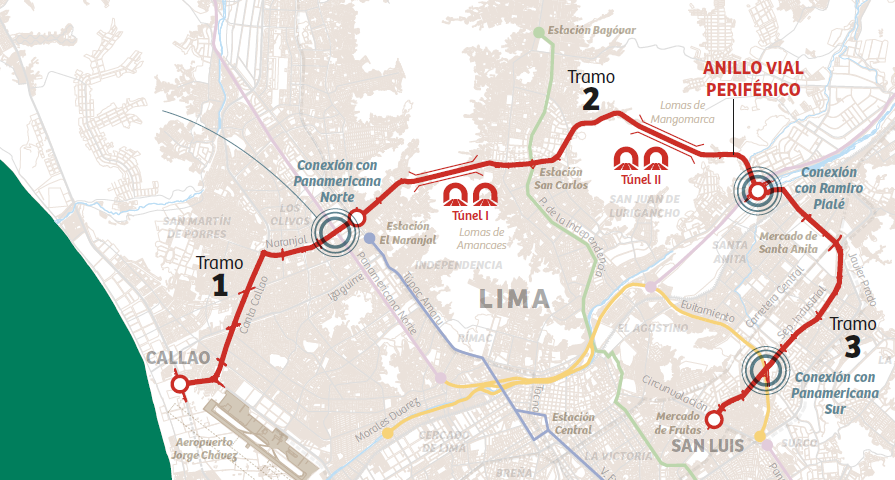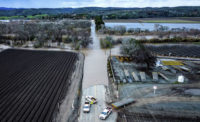The $3.4-billion effort to build a critical 22-mile ring road around Lima, Peru, has been awarded to a Spanish consortium. The Anillo Vial Periférico will encircle the Peruvian capital, crossing 11 districts and the port city of Callao. When completed, it will create a vital link for several major highways that reach the city but do not intersect.
"Investors around the world must get to know that Peru is a reliable and stable country, with safe rules [for investments],” said Peru Prime Minister Gustavo Adrianzen at an April 4 award ceremony. Proinversión, Peru’s private investment promotion agency, announced the award.
Over the past two decades, Peruvian officials have worked to improve the flow of traffic through Lima. One of the first key works was the construction of the Admiral Miguel Grau Freeway in the city's center.
Read ENR's C.J. Schexnayder 2005 story about this project.
Miguel Grau Freeway Leads Lima's Decongestion Road Work
The consortium is led by Cintra, the toll road subsidiary of Ferrovial, and includes Sacyr and Acciona. The group will handle design, financing, construction, operation and maintenance of the megaproject.
The project is being built under a co-financed public-private-partnership model, with the consortium and Peru partially providing the initial investment. The 30-year maintenance and operation concession will allow the consortium to recoup its investment via toll revenues.
The road will feature three tolled lanes. A pair of toll-free lanes will run alongside the highway in each direction. It will include a pair of tunnels of over a mile in length apiece as well as 11 viaducts, 16 underpasses and 18 overpasses.
According to the consortium, the road will incorporate the most advanced technology for traffic management, implementing the use of cameras and other systems for its supervision, with a rapid response model for all types of incidents. It will also install cutting-edge signaling, lighting and safety systems.
To minimize the impacts on communities the road passes through, pedestrian bridges will be built every third of a mile, and green areas will be respected, officials said. The government estimates about 2,600 properties will need to be acquired to make way for the project.
"Anyone affected (by the work on the ring road) will be compensated," the head of Peru's Transportation Ministry Raúl Pérez-Reyes told a congressional commission on Monday. "This is a very important project for the city, which will allow goods to be moved efficiently and people who live at the edges of the city to connect with the other districts."
Construction is slated to begin this summer and will open in stages starting in 2028. The entire project is scheduled for completion in 2034.
A joint venture headed by Ferrovial proposed the project to Peruvian officials over a decade ago. It was then accepted by Proinversión and, in 2016, Peru’s finance ministry declared its viability. The current consortium was formed a year later. The consortium submitted its offer in December this year and competitors were provided a 90-day window to submit an intention to bid.

The Anillo Vial Periférico will connect multiple major highway that lead into Lima's metropolitan area.
Rendering courtesy Ferrovial
A Difficult Connection
The road is intended to address a series of interconnected transportation problems that have long plagued Peru’s capital.
The Lima metropolitan area’s current population of 11.8 million has seen a 50% increase over the past two decades. One consequence of this rapid growth has been gridlock traffic. Peruvian officials estimate the ring road will reduce driving times in the city by half. It will accomplish this by creating a direct route across many of Lima’s outer municipalities, eliminating the need to travel to the center of Lima and back out to any destination.
“It will allow an improvement in interurban connections, in private and public transportation, and an improvement in access to education and health institutions,” Adrianzen said.
The Pan-American Highway, which traverses the country’s western coast, does not run through Lima itself. Instead, drivers must traverse major arterial roads within the metropolitan area, adding to the city’s congestion and slowing transit times for cargo. This is further complicated by the major highway leading eastward to Peru’s interior, Carretera Central, which does not connect with either of the north-south highways.
And perhaps most importantly for trade and tourism, it will create a direct connection between the city of Callao and Lima proper. Callao is the site of the country’s primary port and airport. The lack of a direct highway between Callao and central Lima has long been a source of aggravation for travelers and a damper on shipping productivity.
“[The ring road] will have direct access to the Jorge Chávez International Airport and the Port of Callao, it will reduce logistics costs and improve competitiveness,” said Pérez-Reyes.
The ring road will create a corridor for transporting goods, which also entails Lima’s major arterial roadways. The transportation headaches getting in and out of Callao have long been a problem for Peru. The congestion in Lima hampers the ability to transport the country’s exports, notably the substantial mining materials produced in the highland regions.
The Port of Callao handles approximately 85% of the country’s total cargo. Peruvian exports topped $10 billion dollars in the first two months of this year. The limitations of surface transportation hampers the ability of the port to grow.
That is expected to change as the nation's port's capacity is expanded dramatically with the $1.3-billion Chancay Multipurpose Port Terminal under construction about 40 miles north of Lima. That port project is backed by the China-based firm COSCO Shipping Ports and Peru’s Volcan Compañía Minera Construction.
When completed, the new port will be the only Latin American port able to accommodate Ultra Large Container Ships (ULCS) capable of carrying 18,000 TEUs.
The first terminal for the new deepwater port is slated for completion at the end of this year. A second terminal is also planned.




Post a comment to this article
Report Abusive Comment